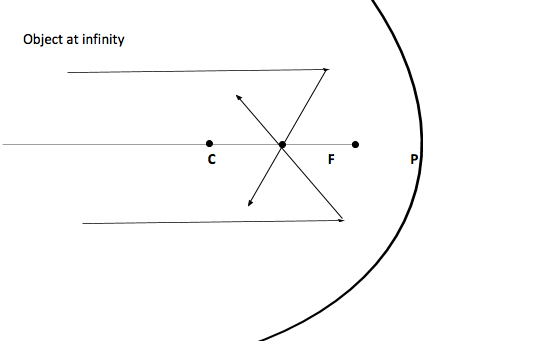
A student observed the image of a burning candle, placed on a table at the farther end of the laboratory, on a screen using a concave mirror. Now the subject teacher suggested focusing a well illuminated distant object to get a better value of the focal length of the concave mirror. Which of the following actions must the student take to obtain the image on the screen?
A) The student must move the mirror away from the screen.
B) The student must move the mirror slightly towards the screen.
C) The student must move the mirror and the screen towards the new distant object.
D) The student must move the screen towards the new object.
Answer
575.1k+ views
Hint:A concave mirror forms an image at its focus when the object is at infinity. The focus of the mirror lies right next to the pole (optical centre) of the mirror and thus choosing a distant object will help in determining the focal length of the mirror. An object beyond the centre of curvature of the mirror is assumed to be at infinity.
Complete step by step answer.
Step 1: Describe the setup of the burning candle used by the student.
The burning candle is placed at the farther end of the laboratory i.e., the object is placed beyond the centre of curvature. As a result, the image formed will be between the centre of curvature (C) and the principal focus (F).
Step 2: Describe the image formed when the student uses a distant object.
As per the teacher’s suggestion, the student is now using a distant object. Thus, the position of the object can be taken to be at infinity. Then, the image will be obtained at the principal focus (F). Now, the principal focus is located next to the concave mirror. Therefore, the student must move the mirror slightly towards the screen to obtain the image and get a better focal length. The focal length of the mirror will be the distance between the mirror and the screen.

Additional information: Focal length is the distance between the pole (centre of the reflecting surface) of the mirror and the principal focus. For a concave mirror, the focal length is negative as it is located along the negative X direction.
Note: When the object is placed at infinity the rays from the image will be parallel to the principal axis. These rays on reflection at the mirror converge to form the image at the focus. The size of the image formed as at the focus can be described as highly diminished and point size and the nature of the image will be real and inverted.
Complete step by step answer.
Step 1: Describe the setup of the burning candle used by the student.
The burning candle is placed at the farther end of the laboratory i.e., the object is placed beyond the centre of curvature. As a result, the image formed will be between the centre of curvature (C) and the principal focus (F).
Step 2: Describe the image formed when the student uses a distant object.
As per the teacher’s suggestion, the student is now using a distant object. Thus, the position of the object can be taken to be at infinity. Then, the image will be obtained at the principal focus (F). Now, the principal focus is located next to the concave mirror. Therefore, the student must move the mirror slightly towards the screen to obtain the image and get a better focal length. The focal length of the mirror will be the distance between the mirror and the screen.

Additional information: Focal length is the distance between the pole (centre of the reflecting surface) of the mirror and the principal focus. For a concave mirror, the focal length is negative as it is located along the negative X direction.
Note: When the object is placed at infinity the rays from the image will be parallel to the principal axis. These rays on reflection at the mirror converge to form the image at the focus. The size of the image formed as at the focus can be described as highly diminished and point size and the nature of the image will be real and inverted.
Recently Updated Pages
Master Class 12 Business Studies: Engaging Questions & Answers for Success

Master Class 12 Economics: Engaging Questions & Answers for Success

Master Class 12 English: Engaging Questions & Answers for Success

Master Class 12 Maths: Engaging Questions & Answers for Success

Master Class 12 Social Science: Engaging Questions & Answers for Success

Master Class 12 Chemistry: Engaging Questions & Answers for Success

Trending doubts
What are the major means of transport Explain each class 12 social science CBSE

Which are the Top 10 Largest Countries of the World?

Draw a labelled sketch of the human eye class 12 physics CBSE

Explain sex determination in humans with line diag class 12 biology CBSE

The pH of the pancreatic juice is A 64 B 86 C 120 D class 12 biology CBSE

Explain sex determination in humans with the help of class 12 biology CBSE




